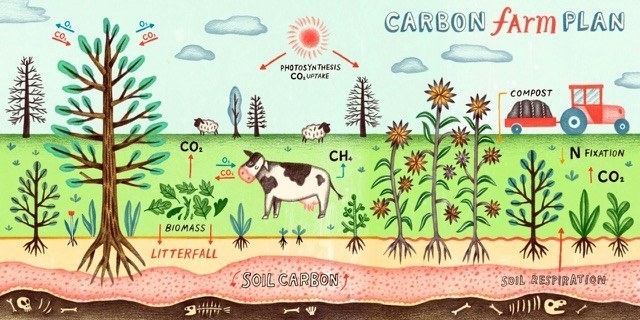The Nuts and Bolts of Carbon Farming
I recently attended a Carbon Farm Plan Training hosting by Restoration Oaks Ranch, the Cachuma Resource Conservation District, and the Carbon Cycle Institute. I had heard about carbon farm plans and understood the concept, but attending this training gave me a much greater appreciation of what the nitty gritty details of creating one of these plans entails.
In a nutshell, a carbon farm plan takes a look at your farm from a carbon cycling perspective. The management practices that take place on the landscape influence the ins and outs of carbon moving through the system. Land management can push the meter towards increasing carbon into the system or releasing it out of the system. Developing a carbon farm plan creates a blueprint of management practices that lead to a net gain of carbon into the land system.
Agriculture is the one sector that has the ability to change from a net carbon emitter to a net carbon sequesterer. Common agricultural practices such as over-grazing, tilling the soil, over application of chemical fertilizers and pesticides, and mismanaged irrigation can result in carbon emissions, contributing to climate change. Removing carbon through harvesting crops without adequate replacement further depletes the carbon content of the soil. Carbon farming relies on plants doing the thing they do best, photosynthesizing, and maximizes the carbon cycle to result in a net gain of soil carbon. In this way, carbon farming improves the rate that carbon dioxide is removed from the atmosphere and converted to soil carbon or plant tissues, allowing agriculture to act as a net carbon sink. This process builds soil organic matter, which then increases water infiltration, enhances water-holding capacity, improves soil structure, and promotes soil microbiota diversity.
A Carbon Farm Plan is a long-term document created through a process modeled after the Natural Resource Conservation Service (NRCS) Conservation Plan. Local Resource Conservation Districts (RCDs) and agricultural support organizations (such as UC Cooperative Extension) provide the planning support to individual farmers and ranchers when creating a Carbon Farm Plan. The process begins with taking an overall inventory of natural resource conditions on the farm or ranch and generating a list of opportunities for enhanced carbon storage. The list of potential practices are refined based on the management goals of the farmer or rancher. Next, the carbon benefit potential for each practice is quantified using a set of online tools (COMET-Planner and COMET-Farm) developed by Colorado State University, NRCS, Carbon Cycle Institute, and the Marin Carbon Project. Once the list of practices are identified, prioritized, and quantified, a document is generated that lays out a plan of implementation based on funding sources and technical assistance.

What practices might you want to include in a Carbon Farm Plan? The NRCS has described many conservation practices that promote soil carbon sequestration and reduce greenhouse gas emissions. Some of these include:
- Cover cropping
- Compost application
- Reduced till or no till
- Multi-story cropping
- Windbreak and shelterbelt establishment
- Silvopasture establishment
- Forage and biomass planting
- Nutrient management
- Range planting
- Hedgerow planting
- Mulch application
A Carbon Farm Plan creates a road map for managing agricultural and working lands through a carbon lens. However, it also provides a working framework to address many ecosystem co-benefits that affect viability of agriculture in a changing climate. Improvements to soil health increase water holding capacity, soil stability and structural integrity, and decreases nutrient and water runoff. In addition, planting herbaceous and woody plants can sequester carbon while improving pollinator habitat. These practices influence the carbon cycle, but more broadly help agriculture build resiliency to drought, water inconsistencies, and temperature variability as the climate changes.
Let's get (carbon) farming!

Climate smart agriculture encompasses management practices that increase soil carbon sequestration, reduce greenhouse gas emissions, improve yields and efficiencies, and promotes climate resilience. The California Department of Food and Agriculture (CDFA) supports three funding opportunities in climate smart agriculture: the Healthy Soils Program, the State Water Efficiency & Enhancement Program, and the Alternative Manure Management Program.
In a collaborative partnership, CDFA and UC Agriculture and Natural Resources have teamed up to support 10 community education specialists throughout the state to provide technical assistance and outreach for the climate smart agriculture programs. As one of these technical assistance providers, my role is to promote and support the adoption of these programs in Ventura County. If you are interested in working with me, please contact me at amrowe@ucanr.edu.

